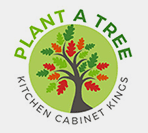15 Types of Kitchen Sinks For Every Kitchen Design
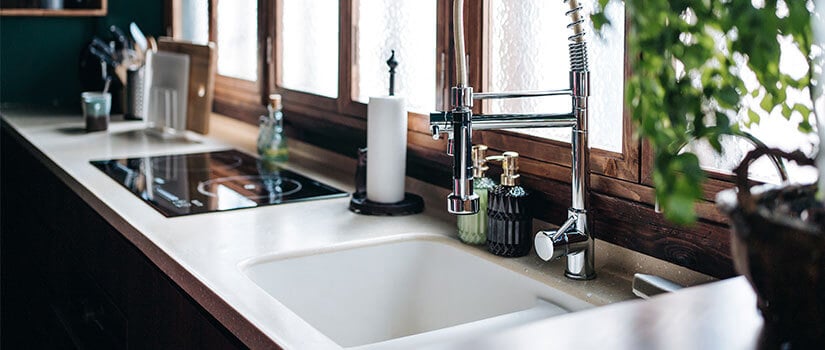
Looking to upgrade your kitchen sink?
Whether you're adding the finishing touches to your kitchen remodel or have picked up a newfound love for cooking and need a more capable workspace, there are many reasons to update your sink.
We have compiled a list of 15 types of kitchen sinks ranging between style and material. Each type contains tips on best uses, pros and cons, and counter-fitting points. Once you've narrowed it down to the type of sink that will best fit your needs, check out our extensive selection of kitchen sinks to find one that suits your kitchen.
1. Single-Bowl Sink
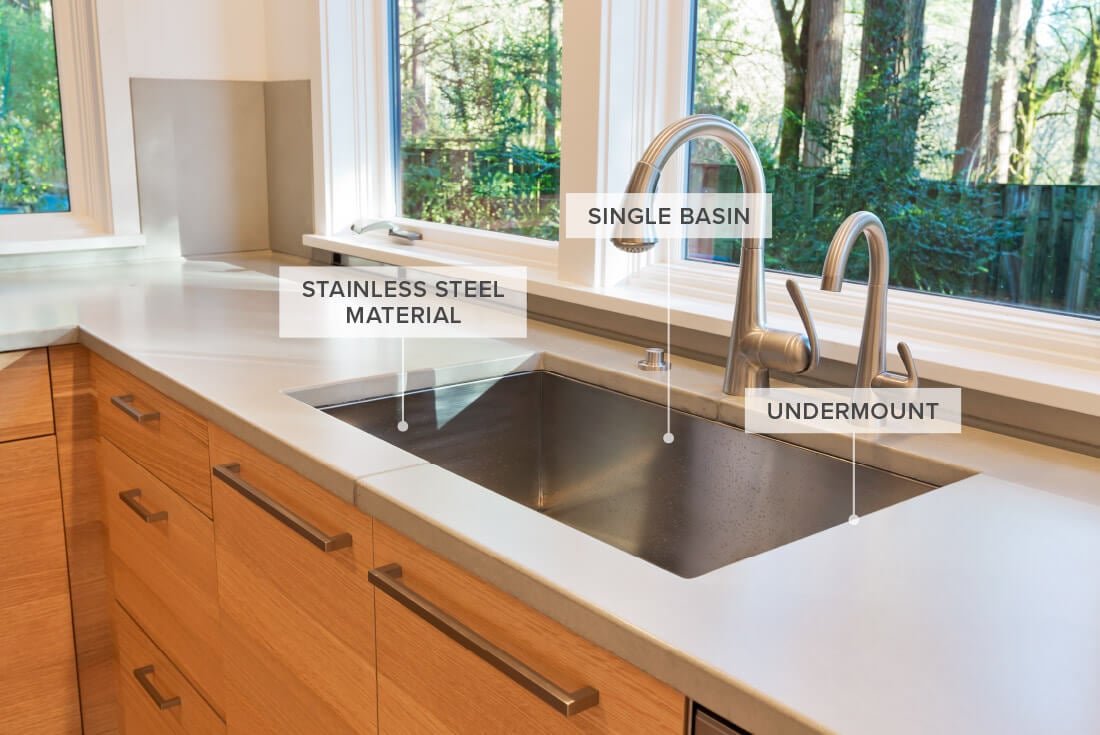
Single-bowl sinks feature one large basin with no dividers and are a great choice for small kitchens with limited counter space. They make cleaning large cookware easier because you can lay pots and pans flat at the bottom of the sink and not have to worry about debris splashing onto your counter.
Single-bowl sinks aren't ideal for multitasking, like cleaning and cooking at the same time, so they're recommended for smaller households or single individuals.
Pros:
- Work well in small kitchens: These sinks use less valuable countertop space than double-basin sinks.
- Roomier: One large basin makes it easier to clean large cookware, like roasting pans and lobster pots.
Cons:
- Can make hand-washing difficult: Without a separate basin to rinse or dry dishes, hand-washing dishes will seem less efficient.
- Drying rack will take up counter space: If you can't use one basin to dry dishes, you'll likely need to place a drying rack next to your sink.
- Less hygienic: With a single-basin sink, there's no way to separate contaminated dishes (like those used for raw meat) from other dishes.
2. Double-Bowl Sink

If you plan to hand-wash your dishes, double-basin sinks can offer both functionality and style. These sinks feature a divider so you can designate one side of your sink for washing dishes and the other for rinsing, drying, or food prep.
These sinks were popular before electric dishwashers became standard, but this classic design has yet to go out of style. double-bowl sinks come in a variety of sizes, colors, and styles, making them easy to incorporate into your kitchen design.
Pros:
- Ideal for hand-washing: Separate basins for cleaning and rinsing make double-bowl sinks the best choice for washing dishes by hand.
- Accessible garbage disposal: Generally the garbage disposal is installed in the secondary basin, so it's still accessible when the main basin is filled with water or dishes.
- Area for food prep: You can designate one basin for dirty dishes and another for vegetable prep while preparing a meal.
Cons:
- Takes up more space: Double-bowl sinks can measure up to 4 feet long, making them less than ideal for small kitchens.
- May be difficult to wash large cookware: Even though these sinks are often larger than single-bowl sinks, separate basins mean less room to wash large pots and pans.
- Wastes under-counter storage: A sink base cabinet has no shelves or drawers, so you'll sacrifice even more storage space for a larger sink.
3. Low-Divide Kitchen Sink
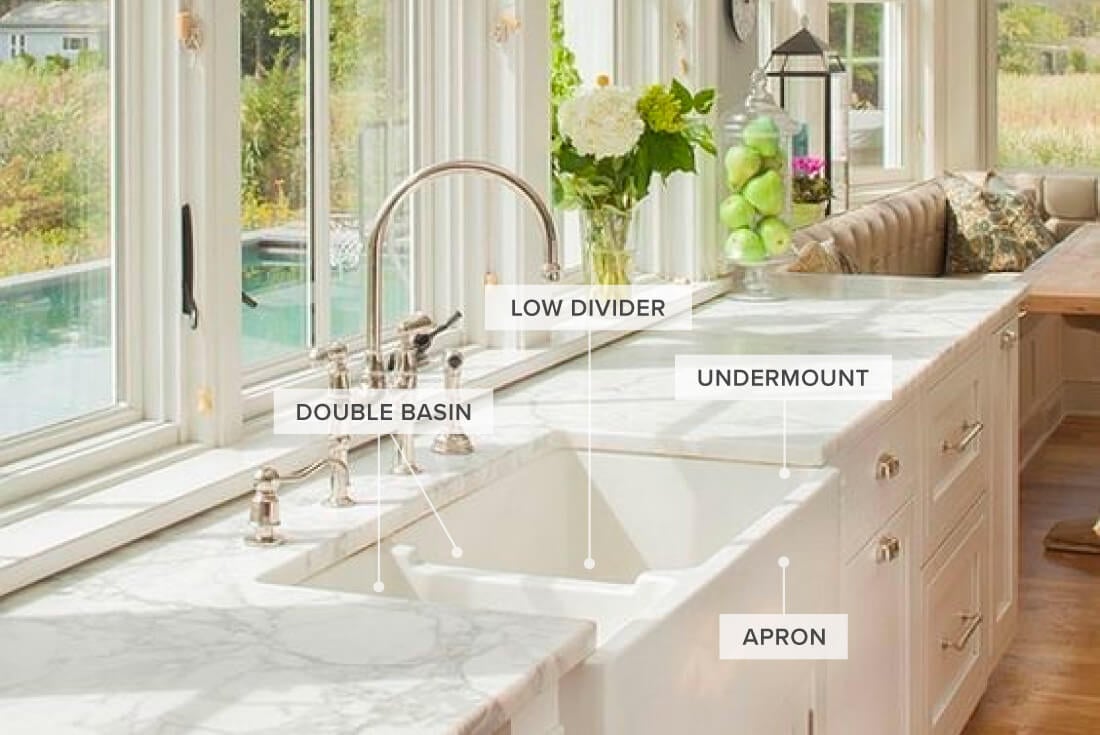
A low-divide kitchen sink, or a low-score sink, has a low center divider that only rises about halfway up the basin. This gives you room to wash larger dishes that wouldn't fit in a double-bowl or single-bowl sink while still being able to organize washing and rinsing into separate basins.
Pros:
- Room for large cookware: A lower divider provides more room to wash large pots and pans.
- Separate basins: With a low-divide kitchen sink, you'll still be able to designate one basin for cleaning and the other for rinsing or drying.
- Can give the illusion of a single bowl: If you want to follow the single-bowl kitchen sink trend without sacrificing the divider, this option is for you.
Cons:
- Shallow basins: You won't be able to fill either side of your sink past the low divide, which proves problematic if you need deep water.
4. Overmount Kitchen Sink
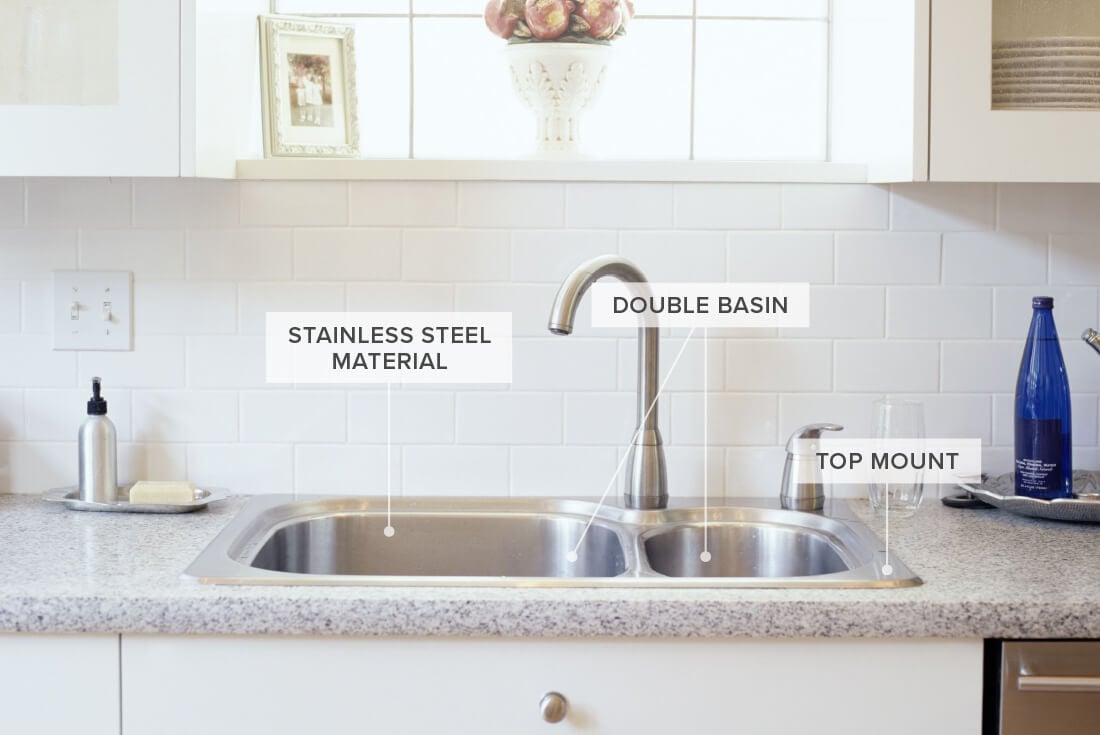
An overmount kitchen sink, also known as a top mount or drop-in sink, drops into the counter which creates a lip or rim around the sink. This is a versatile option because it's easy to install and provides extra support, meaning that you can use almost any material, no matter how heavy.
One factor to consider is that grime and debris can get caught on the lip and can make cleanup more difficult.
Pros:
- Easy installation: Appropriately referred to as drop-in sinks, you should be able to install a top mount sink yourself.
- Affordable: Even with professional installation, overmount sinks will cost less than undermount sinks.
- Good for porous countertops: Overmount kitchen sinks provide a barrier to prevent water damage on the surrounding countertops.
Cons:
- Interrupts countertop flow: The raised lip around an overmount sink may collect crumbs and debris, resulting in mold.
- Takes up countertop space: If you need every inch of countertop space you can get, an overmount sink is not the best choice.
5. Undermount Sink
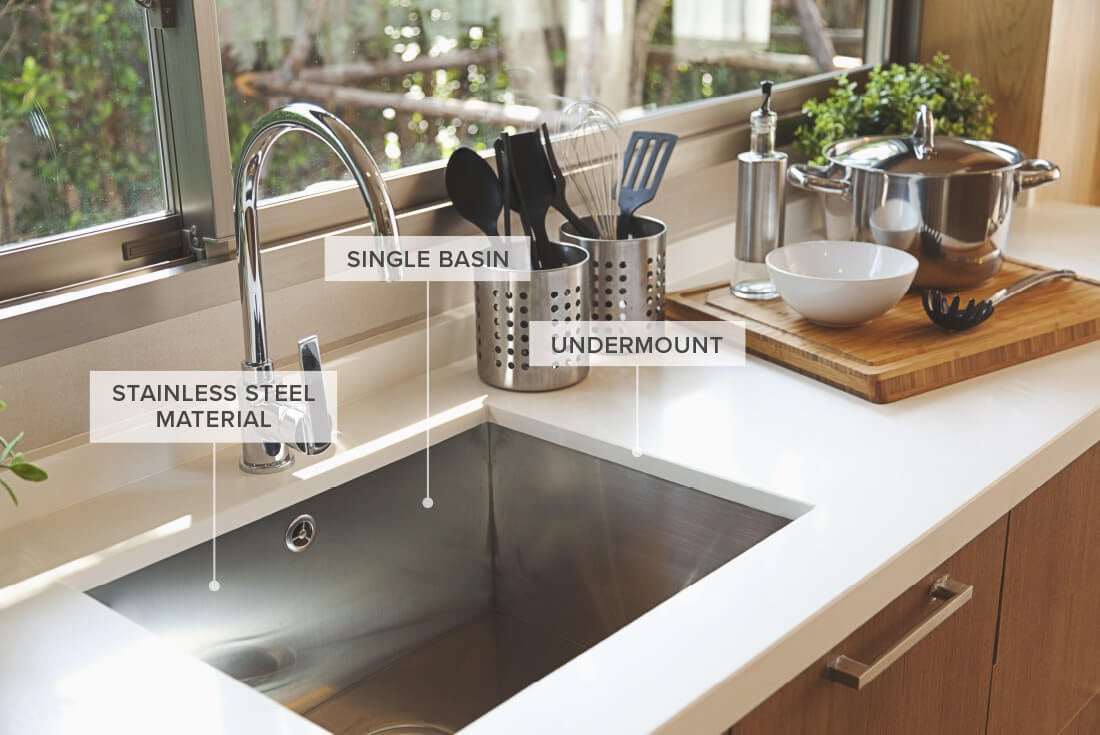
An undermount sink is installed directly under the counter, creating a seamless look from countertop to sink. This type of sink is versatile and works with most kitchen layouts. Not only do these sinks look sleek, but they also make for easy cleanup because debris can be pushed straight into the sink without catching on a lip or rim.
It's worth considering the weight of the sink that you choose since it is typically installed with glue that attaches to the underside of the counter and the sink. Most fireclay or cast iron sinks will not work with this installation method because of their heaviness.
Pros:
- Seamless style: Because the sink lip is flush against the countertop, these sinks create smooth lines perfect for a modern kitchen.
- Easy to clean: You'll be able to wipe away crumbs directly into the sink since the lip is below the counter.
- More counter space: If you use an undermount sink, you'll be able to use your counter space right up to the edge of the sink.
Cons:
- Price: These sinks are often more expensive to install since you'll need to create a custom hole in your countertop.
- Doesn't work with all countertops: Laminate or tile countertops may not be strong enough to support an undermount sink.
- Difficult installation: Hiring a professional to install this type of sink is imperative to avoid serious leakage and improper support.
6. Stainless Steel Sink
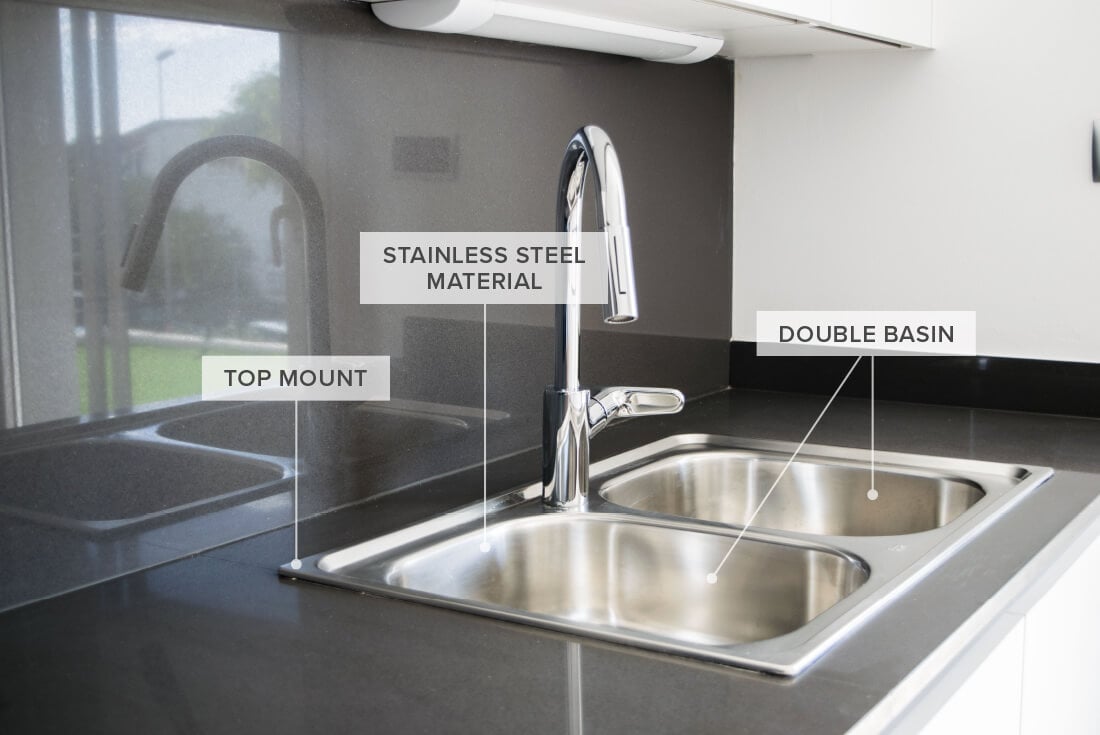
Stainless steel sinks are light and easy to install, making them a functional and popular option. They come in a variety of styles, such as farmhouse, undermount, and overmount. While these sinks are typically more expensive than porcelain, they're an affordable option compared to other high-quality materials like granite.
Stainless steel sinks are categorized by sheeting thickness or gauge. A thicker gauge means the sink will typically be heavier and cheaper, while a thinner gauge will mean the sink is lighter and often more expensive. Stainless steel sinks tend to be noisier than other sink materials and they can dent, but they offer great heat and stain resistance.
Pros:
- Good value: For a high-quality sink, stainless steel is a great middle-of-the-road option that will last forever.
- Durable: Stainless steel sinks never tarnish or rust, and they maintain their shine for years.
- Easy to clean: Stainless steel is nonporous and deflects harmful bacteria from accumulating.
- Versatile: These sinks complement every color or style of kitchen.
Cons:
- Noisy: Expect a lot of crashing and banging when cleaning dishes in a stainless steel sink.
- Susceptible to scratching: Abrasive cleaning agents or metal utensils can cause tiny scratches in the steel over time.
- Can dent: Depending on the gauge, stainless steel can dent under pressure.
7. Cast Iron Sink
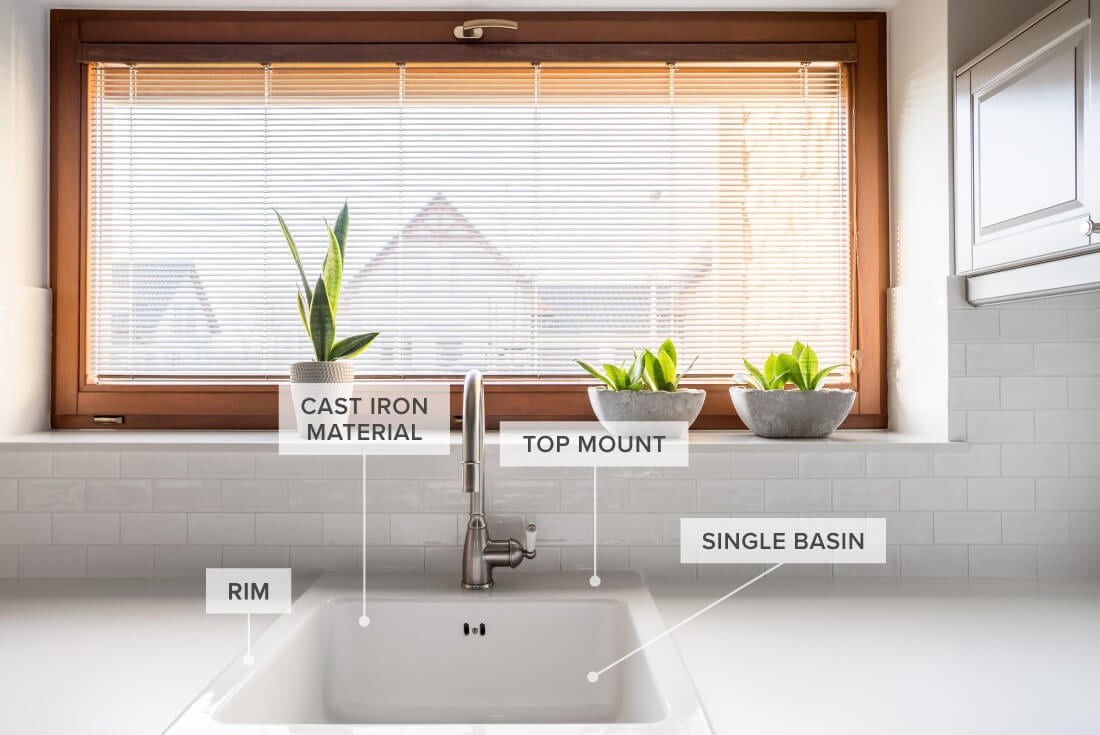
Cast iron sinks are sprayed with a porcelain enamel coating that gives them a glossy white finish, which appeals to many homeowners looking for a sink to complement their vintage, farmhouse, or country-style kitchen.
Cast iron sinks tend to be heavier and more durable than other sinks, but the porcelain enamel can chip easily. These sinks are not meant to be cleaned with abrasive cleaners, as they will wear down the enamel coating. You'll also need to use caution when washing dishes since the hardness of this sink can easily chip your dishware.
Pros:
- Easy to maintain: The smooth porcelain surface allows for quick wipe-downs to prevent buildup.
- Retains heat: If you're sick of the water cooling down halfway into dishwashing, a cast iron sink will fix this.
- Durable: Cast iron sinks are impervious to cracks and dents and will last a very long time when cared for properly.
Cons:
- Price: Cast iron sinks are some of the most expensive sinks to buy and install.
- Enamel can chip: Abrasive cleaners can cause the porcelain coating to get scratched or chipped, leaving the cast iron vulnerable to rust.
- Porcelain will stain: It's very likely the porcelain coating will become stained over time.
8. Fireclay Sink
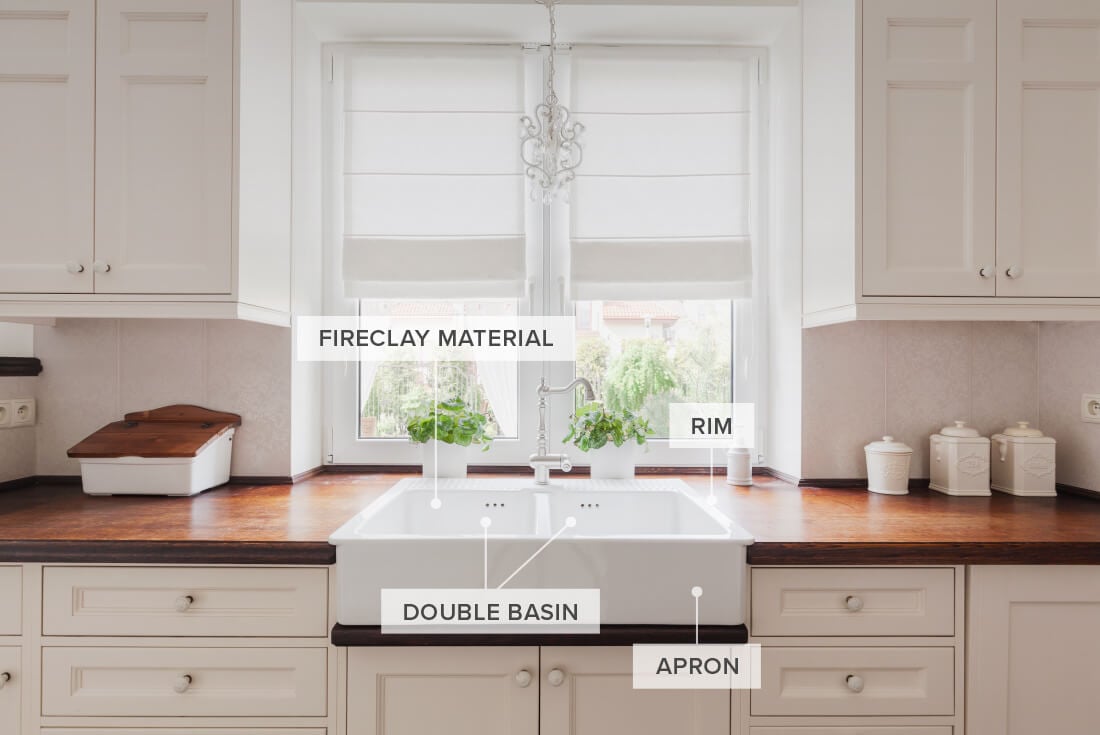
Fireclay sinks are made from clay and glaze fusing together at very high temperatures, upwards of 1,600° Fahrenheit. Fireclay sinks are almost identical to cast iron sinks but tend to be slightly more durable. They won't chip, etch, or stain, and you can use abrasive cleaners unlike on a cast iron sink.
Fireclay sinks are usually more expensive than cast iron due to the more extensive fabrication process. This material is often used for farmhouse-style sinks, making it a great fit for hosting fun events, holidays or entertaining.
Pros:
- Non-porous: Fireclay is nonporous, resistant to acids, and easy to keep clean.
- Relatively chip-resistant: Unlike cast iron sinks, fireclay sinks are less likely to scratch or chip.
- Handcrafted: Even when mass-produced, fireclay sinks are individually handcrafted for a custom touch.
Cons:
- Expensive: Even though fireclay sinks are nearly indistinguishable from cast iron sinks, they tend to cost more.
- Variations from sink to sink: Because fireclay sinks are handcrafted, small variations in size and shape can occur even with the same model.
- Limited design options: Nearly all fireclay sinks feature a single-basin, farmhouse-style design.
9. Granite Composite Sink

Granite composite sinks are constructed by gluing crushed granite together with a resin filler. This type of sink is incredibly durable, stain-resistant, and provides a cutting-edge modern aesthetic to any kitchen.
If you're considering a granite composite sink, they are heavier than stainless steel sinks, so you may want to look into adding structural support to accommodate for the extra weight. Granite composite has an inherent sound-absorbing effect due to its density.
Pros:
- Durable, but still forgiving: Granite composite sinks have all the durability of a full-granite sink, but the composite materials used will also lessen the impact when dishes are tossed in the sink.
- Hygienic: Unlike natural granite, granite composite is highly nonporous and almost hydrophobic, meaning there aren't many places for bacteria to grow.
- Easy to clean: Granite composite does not require chemical cleaners and hard scrubbing to keep it looking brand new.
Cons:
- Price: Though cheaper than traditional granite options, granite composite is a lot more expensive than stainless steel or other materials that offer similar benefits.
- Risk of chipping: Granite composite sinks can chip or crack if heavy pots and pans are tossed around carelessly.
- Bulky and heavy: Due to their size and weight, you'll want help installing these sinks and should consider reinforcing the areas around your sink drop-in.
10. Farmhouse Sink

A farmhouse-style sink, also known as an apron sink, extends over the edge of your counter. This type of sink is most commonly used in a traditional or rustic farmhouse-style kitchen and can be designed with a single bowl or double bowl.
These sinks are gaining popularity with the resurgence of rustic and farmhouse interior design. They typically come as fireclay or cast iron and are incredibly durable and easy to clean because of their nonporous material. Farmhouse sinks have a deep basin perfect for big families, large pots and pans, and easy cleanup. They can be pricey and are more difficult to install because you have to cut out a large portion of your counter.
Pros:
- Chic design: Farmhouse sinks pull inspiration from vintage design, making them a timeless trend.
- Durable: These sinks come in durable materials like fireclay, copper, and cast iron.
- Functional: A large single-basin sink can serve many household purposes, from washing clothes to bathing babies.
- Extra capacity: The large width and depth of these sinks are perfect for soaking hard-to-clean items like grill grates and backing sheets.
- Versatile: Most farmhouse sinks don't include pre-drilled holes for a faucet, which means you have more flexibility to choose the best faucet for your needs.
Cons:
- Price: These sinks are often made from more expensive materials.
- Difficult to install: You have to cut out a large portion of your counter to fit a farmhouse sink.
- Take up a lot of space: Apron sinks are larger than your average kitchen sink and may not work in smaller kitchens.
- Heavier build: Depending on the material, you may need to make some modifications to your existing cabinetry to support the additional weight.
11. Bar Sink
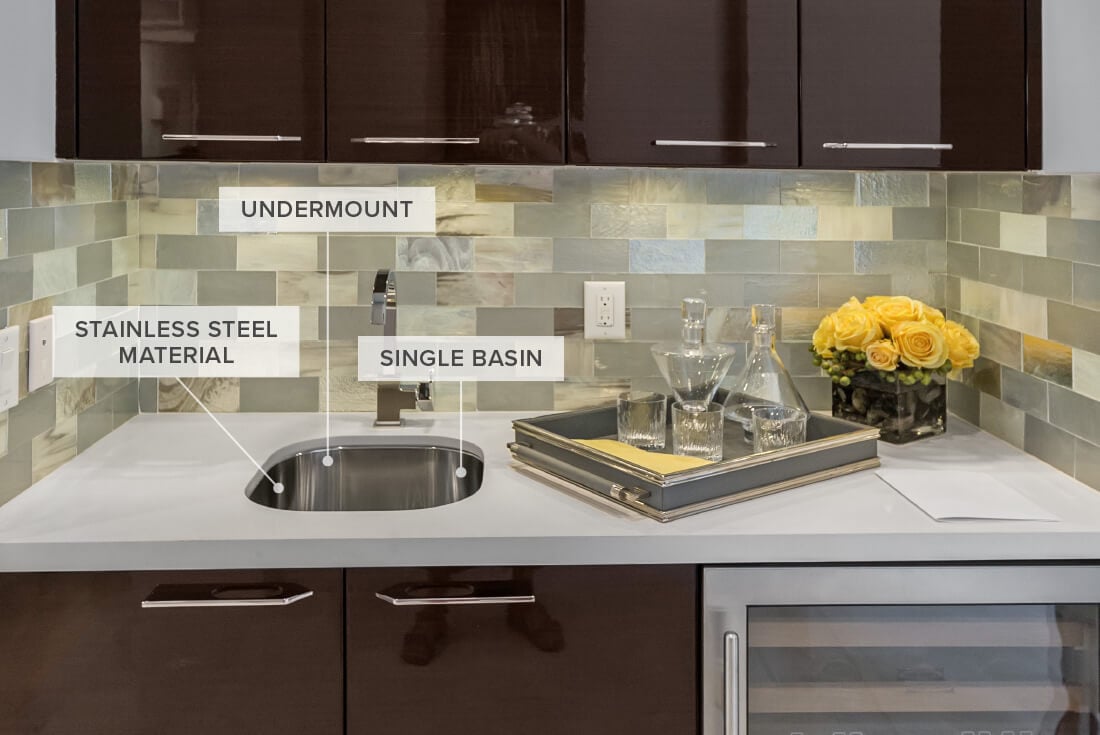
Bar sinks are installed in a home wet bar and are generally smaller and more shallow than your average kitchen sink, making them a secondary option.
They are typically a single-bowl design used for prep work, drink-making, and convenient cleanup. If you have a large family or group of friends, a bar sink is great for entertaining in your home bar, patio, or terrace.
Pros:
- Compact: Bar sinks are much smaller than full-sized traditional sinks and can be strategically placed in a spot that may be difficult to use in other ways.
- Efficient: These secondary sinks are convenient for meal prep and cleanup, especially when there's more than one chef in the kitchen.
- Versatile: Bar sinks come in a variety of sizes and materials that can be tailored to fit your needs.
Cons:
- Small: Even as a secondary sink, a small, shallow basin may limit usage.
- Added expenses: An additional sink means additional costs that will need to be factored into your budget.
12. Corner Sink
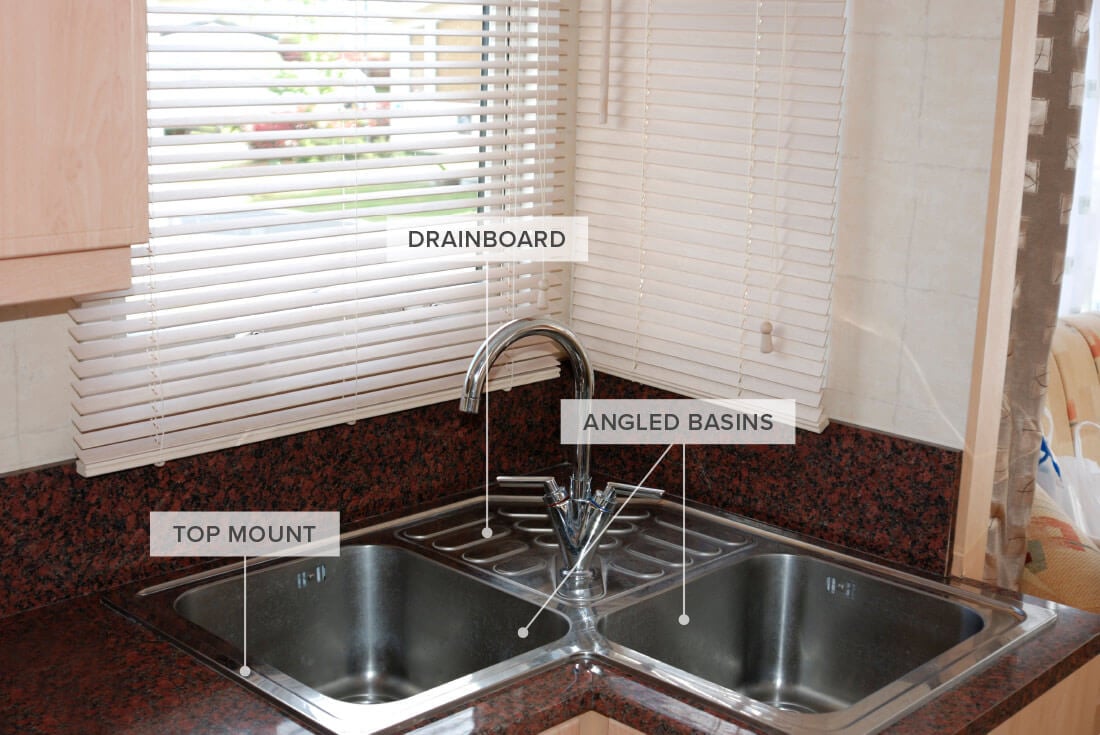
Corner sinks are double-basin sinks installed on a corner of your counter. The two basins are set apart from each other in a catty-corner manner. This is a relatively unique design that can be useful if you are looking to maximize your counter space.
Corner sinks can be expensive and difficult to install. Since most counters are seamed at the corner, custom cuts in the counter will add to the total cost of installing this type of sink.
Pros:
- Efficient use of space: Corner sinks take up an area of the counter that is typically difficult to use for other purposes.
- Unique design: These sinks are far less common than traditional sink styles and will make an interesting focal point in your kitchen.
Cons:
- Difficult to install: Corner sinks require a customized installation process, including custom cuts in your countertop.
- Make it hard to help: More than one person around a corner sink quickly becomes crowded, meaning you may have to forgo help when prepping meals or washing dishes.
13. Kitchen Island Sink

Kitchen islands are becoming increasingly popular and with that, so are kitchen island sinks. These sinks can be used as a primary or prep sink, depending on your needs.
Kitchen island sinks are a great way to complement your workflow and save you space on your main counter. They can also turn your kitchen island into a complete workspace. They look beautiful on a wood, granite, or stainless steel island, so your options are endless in terms of design. If you are thinking about adding a sink to your kitchen island, be sure to consider the extra costs of installing plumbing to your kitchen island.
Pros:
- Functional: Placing your sink on your kitchen island can optimize your workspace.
- Saves counter space: For galley kitchens or other smaller kitchen layouts, placing the sink on the kitchen island opens up valuable countertop space against the wall.
- Better washing experience: A kitchen island sink means you can still take part in conversations while cleaning up - you won't have your back turned on guests.
Cons:
- Additional costs and installation steps: Installing a sink on your kitchen island means you'll have to install a water feed and waste pipe in your island as well.
- Might be a mess: Allowing dirty dishes to accumulate in the sink and may take away from the appeal of the kitchen island.
- Won't work with every island: To achieve the functionality this type of sink can offer, an island will need enough space for the sink, an area to stack dishes, and ideally a dishwasher.
14. Kitchen Sink With Drainboard
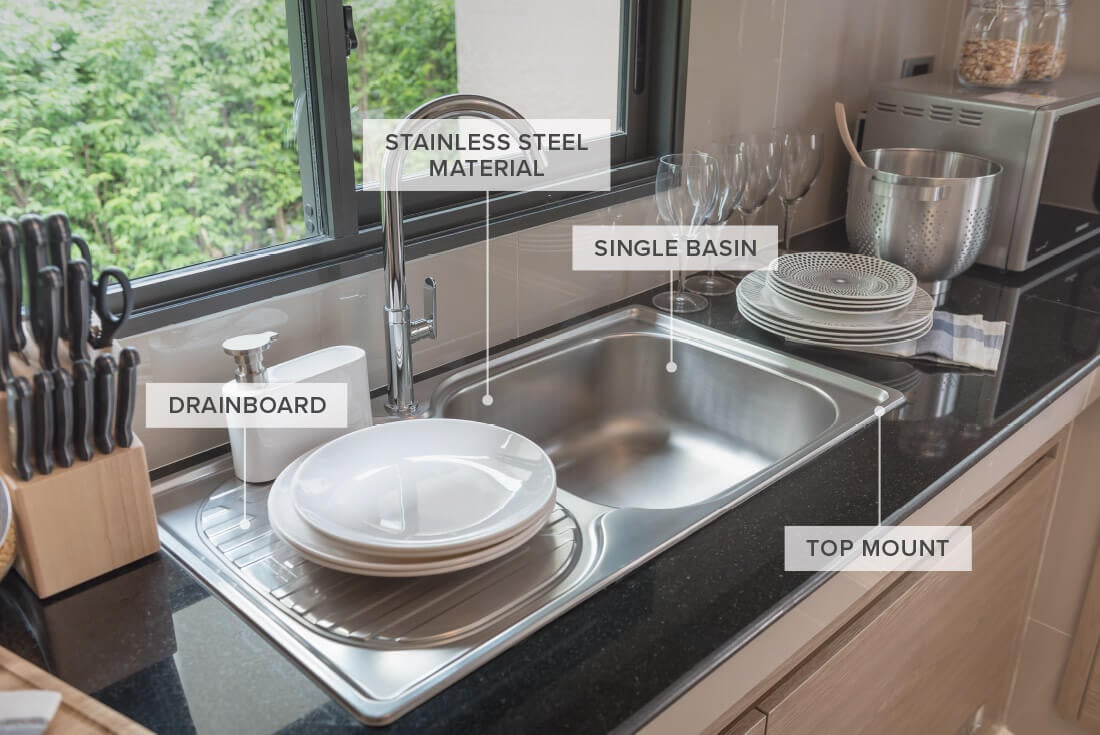
Kitchen sinks with drainboards are practical and eco-friendly. Typically found in stainless steel, drainboard sinks have an attached apron (the drainboard) that allows water to drain directly into the sink.
If you love to cook, drainboard sinks are a great option because they create a designated food prep section of your counter. The drainboard also provides a spot to dry dishes and other kitchenware by allowing excess water to run off into the sink. This method leaves you with cleaner counters and saves energy by not using your dishwasher to wash and dry dishes.
Pros:
- Keeps countertops dry: Built-in drainboards make countertop drying racks obsolete.
- Allows full use of double-basin sinks: Instead of designating one basin to dry plates, drainboards free up both sides of twin-basin sinks.
- Saves energy: Using your sink to wash and dry dishes saves the energy needed to run a dishwasher.
Cons:
- Take up counter space: Drainboard sinks require more counter space than traditional sinks.
- Price: These sinks are considered a specialty item and are priced accordingly.
- Not everyone's style: While drainboard sinks are incredibly efficient, not all homebuyers will be drawn to their unique style.
15. Integrated Kitchen Sink
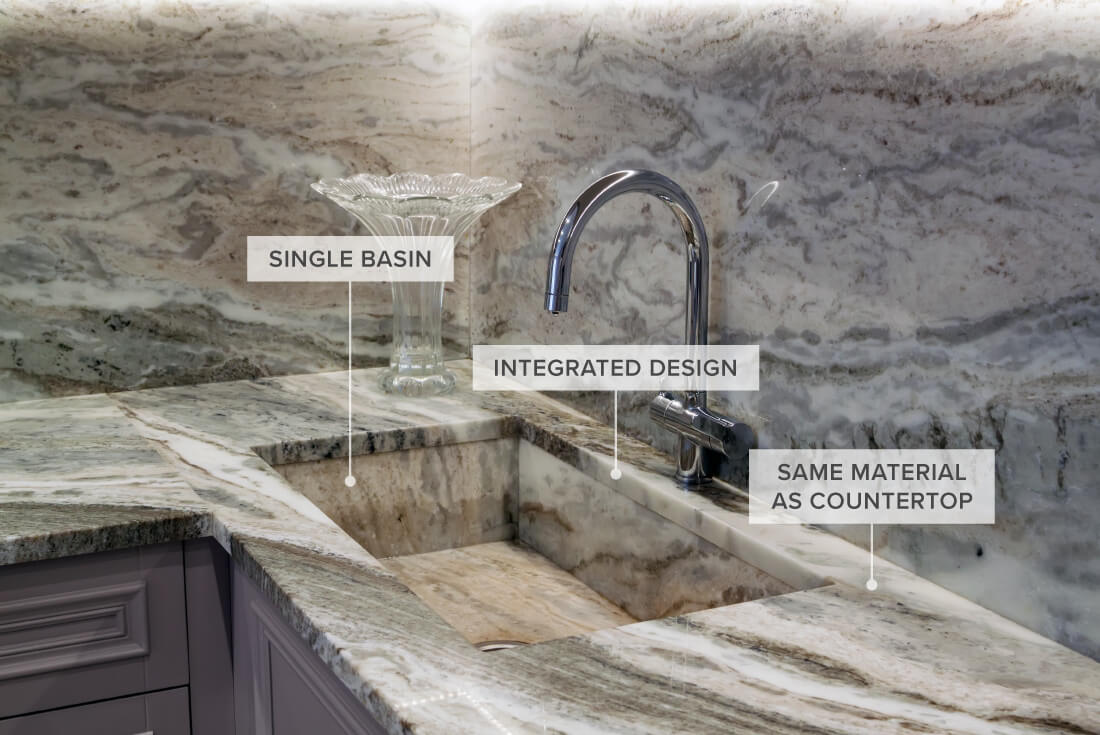
If you're looking for a uniquely customized option that can serve as a statement piece in your kitchen, an integrated kitchen sink is unparalleled. These sinks are integrated within a countertop and constructed of the same material - in most cases, in one piece - providing a sleek and seamless look.
However, this style of sink can be very expensive compared to other types of kitchen sinks. Because integrated sinks are essentially basins built right into your countertop, they may carry a sizable additional expense with some materials, such as marble.
Pros:
- Cohesive design: By eliminating the overlap of countertop characteristic of drop-in sinks, integrated sinks provide a streamlined, minimalistic look.
- Easy to clean: The absence of caulked edges and seals makes for a nearly maintenance-free design that only requires a casual wipe-down.
- Highly customizable: This type of sink will be completely unique to your home - you'll determine the material, size, and shape.
Cons:
- Expensive: The luxurious look of an integrated kitchen sink requires professional designers, installation, and a large price tag.
- Irreplaceable: Replacing or altering your integrated sink means replacing the entire countertop.
- May not be as durable: Depending on the material you choose for your countertops and sink, an integrated sink may be more susceptible to stains and scratches.
Types of Kitchen Sinks FAQs
Still deciding which type of kitchen sink will work for your space? Here are a few kitchen sink FAQ to help with your decision.
What type of kitchen sink is best?
The best kitchen sink will depend on your style preference and needs. Each style has its own advantages and disadvantages. If you're looking for a cost-effective option, a stainless steel top-mount sink may be your best choice. If style is more of a priority, a farmhouse sink or integrated kitchen sink will have that wow factor you're looking for.
What is the current trend in kitchen sinks?
Large, single-bowl sinks are the latest trend in kitchen sinks. These multipurpose sinks are ideal for small kitchens and those seeking an affordable modern kitchen sink design.
Are stainless steel sinks out of style?
Like white-on-white kitchens, stainless steel sinks will always be in style. However, innovative alternatives like granite composite and fireclay sinks have recently stolen the spotlight.
What is the most popular type of kitchen sink?
Drop-in sinks are the most popular type of kitchen sink due to their affordability and easy installation process.
Before you make your final decision on a kitchen sink, consider your cooking habits, cleaning needs, counter space, style, and budget. These key factors will help you determine what sink best suits you and your lifestyle.
For more kitchen remodeling inspiration, check out our collection of kitchen design ideas and start planning your dream kitchen.























